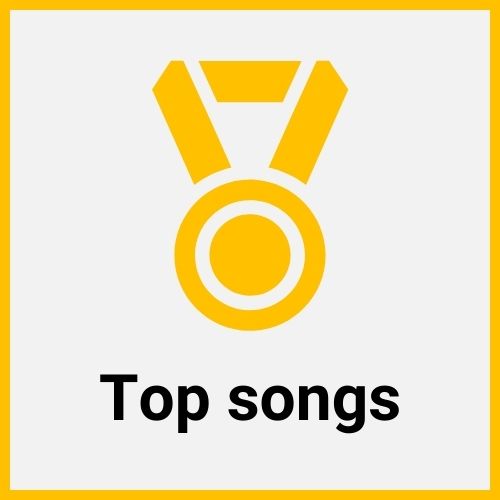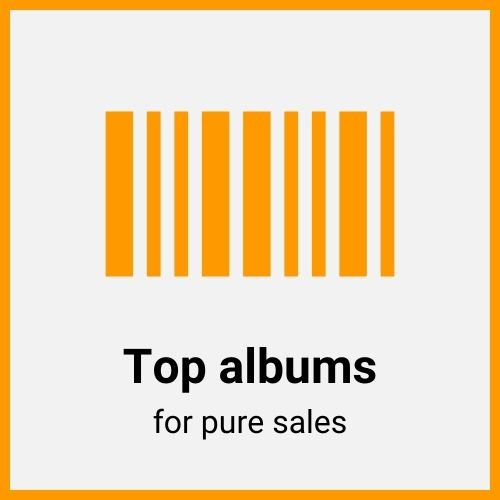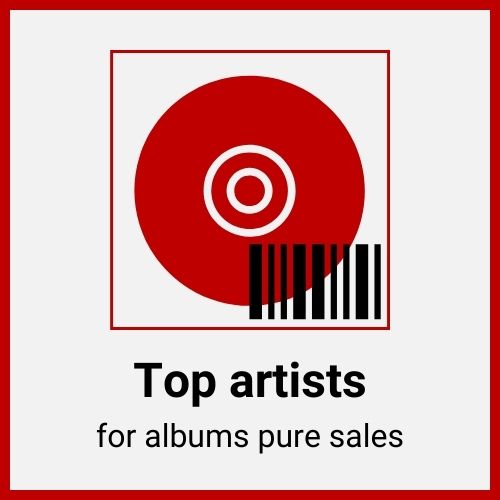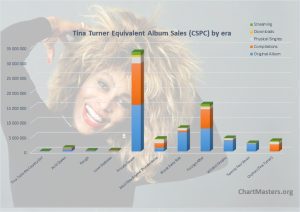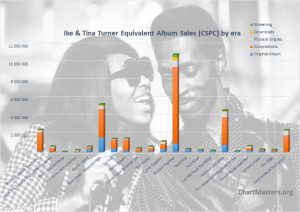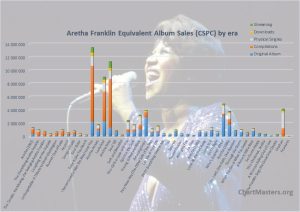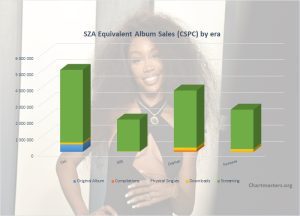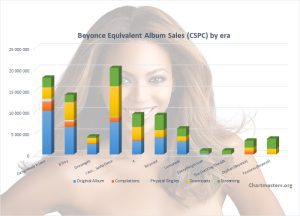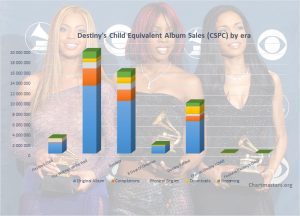The Supremes albums and songs sales
Kicking the formidable run of the Motown label in the 60s, The Supremes propelled the black music scene to headlines in one of the busiest eras of all-time.
Their hits sold tons of copies, and remained widely loved ever since. For the first time ever, we publish a comprehensive review of their records’ sales and streams.
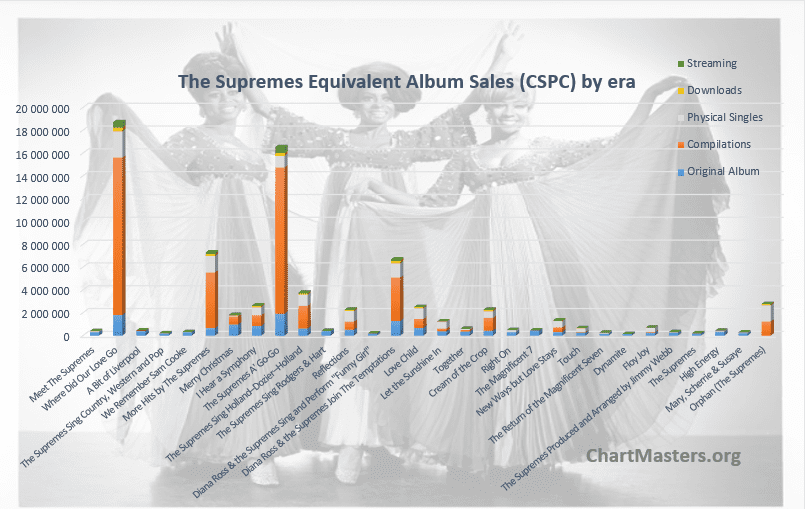
Looking at the big picture: The Supremes
The Primes and the Primettes
By 1959, Paul Williams and Eddie Kendricks, were part of the group The Primes which was starting to make noise around their city of Detroit.
They had ties with Florence Ballard and Betty McGlown, who could sing too. The Primettes were born. Mary Wilson and Diana Ross were quickly recruited as well.
This bunch of young people – the girls were 15-16 of age, the boys up to 20 – was going to found two of the most successful American bands of the 60s, as a year later The Primes became The Temptations, while The Primettes were rebranded The Supremes when they were signed by Motown.
The Soul and R&B label itself was growing. As Tamla records, they scored their first pop #1 single with The Marvelettes‘ Please Mr. Postman in December 1961.
Both The Supremes and The Temptations were already issuing singles at that point, but all failed to have any impact. In 1962, both dented Billboard charts for the first time with minor hits, respectively Your Heart Belongs to Me (#95 in the Hot 100) and (You’re My) Dream Come True (#22 on R&B charts).
The former convinced Berry Gordy, the Motown’s owner, to maintain Diana Ross as the lead singer after many switches in early recording sessions. It was also the last song to feature Barbara Martin who left the group after replaacing Betty McGlown, making it the famous trio that the main audience was going to meet soon.
Motown music goes mainstream
In August 1963, Tamla Records, on its way to become the Motown a few months later, got a second number one hit. Fingertips, by the promising 13 years old singer Little Stevie Wonder led for 3 weeks.
From that point, everything accelerated for the motor town company. The Supremes climbed to #23 with When the Lovelight Starts Shining Through His Eyes. This single was written by new trio Holland–Dozier–Holland, who penned multiple Top 40 hits that year for Martha and the Vandellas, The Miracles, Marvin Gaye and Mary Wells. Their first collaboration with The Supremes, the legendary songwriting and production team would become key to their success.
With this outstanding roster, Motown became unstoppable. Mary Wells, dubbed the Queen of Motown by then, got a #1 hit with My Guy in May 1964.
Months later, The Supremes exploded as Where Did Our Love Go became their first #1 hit in the US by August. It was quickly followed by Baby Love, which also turned into their first chart topper in the UK. Incredibly, the year wasn’t over that they managed a three-peat, climbing to the summit with Come See About Me. All three of them were from the same album, Where Did Our Love Go, itself a huge #2 smash.
A week before the end of the year, their buddies The Temptations put the cherry on the cake for Motown, releasing My Girl, that would reach #1 in early 1965.
It wasn’t over as a couple of weeks later The Supremes‘ reclaimed the top of pop charts once more, this time with Stop! In the Name of Love. They increased their string of consecutive chart toppers to 5 thanks to Back in My Arms Again that same year, itself topped by new Motown stars the Four Tops with I Can’t Help Myself.
The Supremes continue their reign
While their run of #1s was broken by the #11 song Nothing but Heartaches, the group continued to be super strong, adding a new leader with I Hear a Symphony months later. Then, they got a new run of 4 leaders in 66/67.
In fact, from 1966 to 1969, they were responsible for 7 of the 8 Motown leaders, pushing their career tally to 12. They also topped charts with at least one song every year from 1964 to 1969, a milestone shared with the Beatles.
This is possibly the most impressive fact on this immaculate run, as The Supremes achieved all these feats while competing with the British invasion. In truth, while The Rolling Stones or The Beach Boys were often regarded as the Beatles‘ rivals, on charts their main challengers were clearly The Supremes.
Diana Ross takes over the spotlight and then moves on
From 1967, the main focus was put on Diana Ross, with the group being renamed Diana Ross & The Supremes. This led to internal tensions, especially with the lead singer being dated by label boss Berry Gordy. Florence Ballard struggled the most, suffering from depression and alcoholism. As she became unable to attend recording sessions and concerts in time and in good shape, she got replaced by Cindy Birdsong that year. After going through an unsuccessful solo career, she tragically passed away in 1976, aged only 32.
Cindy Birdsong herself as well as founding member Mary Wilson started to miss many recording sessions, where Diana Ross was accompanied by session vocalists. Behind the closed door, the perfect harmony image shown outside on their visuals and performances was in ruins.
These weren’t the biggest departures still, as a clash with Motown led Holland–Dozier–Holland to leave at the start of 1968. While with them, starting from they breakthrough, The Supremes registered 8 #1s and 14 top 10s out of 16 singles, without them they got only 6 top 10 hits out of 32 singles. They still got big hits with Love Child (#1), I’m Gonna Make You Love Me (#2) and Someday We’ll Be Together (#1).
The latter was their final hit with Diana Ross, which closed the decade by leaving the band in order to pursue her solo career. The was the end of an unbelievable run of 18 studio albums in less than 7 years, plus countless compilations and live sets. A Farewell double-live album recorded at their final concert at the Frontier Hotel in Las Vegas on January 14, 1970 celebrated them.
The band kept going though as Jean Terrell jumped into Diana Ross‘ shoes, proving to be successful still. Despite multiple members’ changes, which saw they released 11 more studio sets until 1976, scoring 2 more top 10 hits and 8 top 40 entries in the US, plus 5 Top 10s in the UK. During these later years, Lynda Laurence, Scherrie Payne, and Susaye Greene also enjoyed their time as a Supremes member, making it a 10-women club, with Mary Wilson remaining the lone founding member throughout its entire trajectory.
Royalties cheats and sales mysteries
While the success of the Supremes on charts is easy to verify, there have been a lot of myths about their records sales, with a lot of mytery surrounding them.
This situation is true for all Motown legends. This is due to the aforementioned founder Berry Gordy. Some may say the famous record executive hid real sales figures to inflate their results, others that he did so to underpay his artists. Their dreadful royalties in early years are well documented.
Nevermind, the concrete impact was that Gordy refused to affiliate to the Recording Industry Association of America (RIAA) until 1978, meaning that Motown records prior to this date weren’t certified.
This left a door open to all the fantasies, with songs soon claimed to be over 1, 2, 3 million US sales or even more.
When we adopt a larger view, auditing all the big to moderate hits from 1964, and comparing it to the 200 million yearly singles sold in the US, we can quickly refine numbers and get a much more realistic understanding of Motown’s artists sales.
To compile this article, we went deep into the tank for several weeks to unveil sales from The Supremes as well as Diana Ross. The first half of results is listed below!
The Commensurate Sales to Popularity Concept (CSPC)
As usual, I’ll be using the Commensurate Sales to Popularity Concept in order to relevantly gauge their results. This concept will not only bring you sales information for all The Supremes‘ albums, physical and download singles, as well as audio and video streaming. In fact, it will also determine their true popularity.
If you are not yet familiar with the CSPC method, below is a nice and short video of explaining the concept. I recommend watching it before going on the view the sales figures. Of course, if you are a regular visitor feel free to skip the video and go straight to the numbers!
There are two ways to understand this revolutionary concept. The first is the Scribe video posted below. If you are unaware of the CSPC method, you will get the full idea within a few minutes.
If you are a mathematical person, and want to know the full method as well as formulas, you can read the full introduction article.
Now let’s get into the artist’s detailed sales figures in order to apply this concept and define the act’s true popularity!
The Supremes Album Sales

Updated Studio Album Sales & Comments
On surface, these album sales look unimpressive. The two best performers, Where Did Our Love Go and The Supremes A’ Go-Go, fail to hit 2 million sales. Below, only Diana Ross & the Supremes Join The Temptations reaches a million.
This was another era though, where singles were reigning, and studio albums were released every 4 to 6 months with live sets and compilations replacing them straight away.
Where Did Our Love Go actually performed very well under this environment. It peaked at #2 for 4 weeks in the US blocked by The Beatles‘ 65 album. The album remained on charts for 89 weeks, impressively outlasting the debut of their 6 following albums.
They got some kind of a revenge a year later, when The Supremes A’ Go-Go climbed to the top, dislodging The Beatles‘ Revolver. More Hits by the Supremes, I Hear A Symphony or Sing Holland-Dozier-Holland also made the top 10.
The pace of releases never went down, with a ridiculous 5 new LPs entering the Billboard 200 during the last quarter of 1968 alone. Their paired album with the Temptations went to #2, stopped by… The Beatles‘ White Album. Another The Supremes – The Tempations paired album, TCB, ended with the latter’s run at the top by climbing to 1 in the chart dated February 8, 1969. This album isn’t listed here as it’s a compilation, it is listed lower down in the appropriate section.
In total, the Supremes‘ studio albums add for almost 15 million pure sales. As one can understand, the bigger part of the picture appears on upcoming physical singles and compilations parts. Keep on reading…
Want to compare The Supremes’ albums with others?
The Supremes songs sales
Below, we list down results from the artist through physical sales, digital sales and streaming.
Please be aware that when the artist is regarded as the lead act, they are rewarded with 100% of these units. However, featured acts share a 50% piece of the total.

Physical Singles
As a reminder, the weighting is a 10 to 3 ratio between albums and physical singles.
The popular culture is full of bold claims about singles selling a million plus copies in no time, especially in the 60s. At that time, most media were unaware of communications tricks from labels executives and RIAA certifications being based on units shipped to retailers rather than sold to consumers.
The reality was that selling a million copies of a single was a big deal, and it took monster US hits or strong global smashes to reach 2 million sales.
It’s with these metrics in mind that we should appreciate physical singles sales of the Supremes.
Where Did Our Love Go comes close to 3 million sales, including 2.4 million from its original release. This is a terrific figure, putting it among the very best selling singles from 1964.
This would have been the hit of a lifetime for many artists, but the iconic vocal trio continued to hit again and again and again.
Both Stop! In The Name of Love and Love Child stand at 2.6 million, while You Can’t Hurry Love and Baby Love are around 2.3 million across all their versions. A chart trivia stat: their 5 best selling physical singles all include the love word.
You Keep Me Hangin’ On ends up out of their top 5, something incredible considering it sold 2 million units. No need to say that they were all US #1 hits. Baby Love was the only one to reach this position in the UK though, even if most of them were solid top 10 sellers.
We need to go all the way down to Stoned Love to see the first non-#1 hit, well, at least not a pop #1, as this single still topped the R&B ranking. It charted at #7 in the Hot 100, and #3 in the UK. It’s the group’s best selling single after the departure of Diana Ross. It shows how well they managed to survive this event, as Stoned Love sold about the same as Someday We’ll Be Together, their final hit with the popular leader.
Their very first song without her was another million seller as Up the Ladder to the Roof moved 1.15 million copies. It was also another transatlantic top 10 hit. They almost made it 3 times to this level in their first year under the new lineup, as River Deep, Mountain High came close. This version actually outsold the original song released by Ike & Tine Turner a few years earlier.
This comparison reflects perfectly how stunning physical singles sales of The Supremes are: River Deep, Mountain High is Ike & Tina Turner‘s 3rd biggest seller, yet it’s outsold by The Supremes‘ version which is barely their 21st top seller.
Their personal ranking is in fact incredibly stacked, with no less than 19 million sellers. All of them were released from 1964 to 1970. From that golden era, their worst selling singles were still selling 400,000 units.
All in all, The Supremes total over 46 million physical singles sold, including a stunning 34 million US sales.

Digital Songs
As a reminder, the weighting is calculated using a 10 to 1.5 ratio between albums and digital singles.
While they have no truly big digital seller, The Supremes impress with their consistency. Their biggest title is You Can’t Hurry Love. A classic, both for them and for Phil Collins who successfully covered it in 1982, the evergreen track tops a million downloads and ringtones for the girl group.
Not too far behind is Baby Love. The 1964 song, extensively used on TV ads for decades, ended up becoming a bigger long term hit than its album’s title hit, Where Did Our Love Go. This one is still a sizable hit, with half a million sales.
Also close to a million is Ain’t No Mountain High Enough. A classic for Marvin Gaye & Tammi Terrell, the song got popular versions from both Diana Ross & The Supremes, and then Diana Ross solo. The total listed here combines all their versions of the track.
Most of their #1 hits claim relevant sales on downloads, averaging almost half a million a piece. Among their leaders are Someday We’ll Be Together at more than 700,000, and Stop! In the Name of Love.
They do have some former hits with less memorable results nowadays, at less than 200,000 sales, mostly their later songs. Among them are Stoned Love, Nathan Jones, or even Back in My Arms Again, arguably the most forgotten track from the massive 1964-1966 years.
Their catalog records just over 10 million digital sales in total, a very respectable total among 60s vocal groups.

Streaming
Streaming is made up of both audio and video streams. Our CSPC methodology includes both formats to better reflect the real popularity of each track.
The main source of data for each avenue is Spotify and YouTube, respectively. To factor in the growing impact of multiple Asian countries where these platforms aren’t always the go-to site for music streaming, more sources have been added.
In order to account for their real popularity in each relevant country, the below sources have been used along with the mentioned ratios that reflect the market share of each area.
Audio Streams
– South Korea: Genie streams * 2.20 (consistent with Gaon streaming numbers)
– Japan: AWA streams * 100 / 4 (AWA has 4% of the Japanese streaming market)
– Arabic world: Anghami streams
– Sub-Saharan Africa: Boomplay + Audiomack streams
– Elsewhere: Spotify streams * Spotify market shares based on artists’ market distribution
Video Streams
– China* : QQ video streams * 50 if the song is available for audio stream, QQ video streams * 5 elseway (scale built based on known figures for several major artists)
– Elsewhere : Youtube views increased by 10% to account for various local platforms
*since Chinese streaming platforms are mostly video streaming platforms, their streams are weighted on par with YouTube streams.
Audio Stream value – 1,500 plays equal 1 album unit
Video Stream value – 6,750 views equal 1 album unit
Equivalent Albums Sales (EAS) = ( Spotify * ArtistRatio + Genie * 2.20 + AWA * 100 / 4 + Anghami + Boomplay + Audiomack ) / 1500 + ( QQ views* 50(or 5) + YouTube * 1.1 ) / 6750
Top Hits

You Can’t Hurry Love dominates streaming just like downloads, this time with a comfortable lead. With over half a million equivalent album sales from streams, it’s one of the biggest hits from 1966.
Baby Love is a solid runner up, with 240,000 EAS. We can notice that both songs have very small numbers in Chinese and South Korean platforms, despite a great success through their career in Japan or in markets like Indonesia.
A quartet of strong songs follow, each cracking 100,000 EAS. These are Stop! in the Name of Love, Where Did Our Love Go, Ain’t No Mountain High Enough and Come See About Me. Behind these great performers, which are often featured on Motown / R&B popular playlists, times are darker for the rest of their catalog. You Keep Me Hangin’ On is, indeed, hanging around, and then Someday We’ll Be Together.
Numbers go down quickly though, with no more song reaching 30,000 EAS. One of the biggest disappointments come from fan-favorite I Hear a Symphony, at only 19,000 EAS. Also worth noting that their Christmas material, usually highly popular on streaming platforms, even more for vocal acts, records very modest scores. The top track among them, My Favorite Things, is their 18th most streamed track at 10,000 EAS.
Another interesting point is how their Spotify streams top their YouTube views by 4 to 1. It shows both, the absence of high quality video for their songs as often with 60s artists, but also their lower success in majors where YouTube is huge, like South America and India.
The combined total of their discography stands at 1.7 million equivalent album sales from streams.
Full catalog breakdown
If you are familiar with the artist’s catalog and want to check details of each and every song, you can access to all of them right here.
Keep yourself up to date
Our website provides you a fantastic tool which fetches updated Spotify streams as you request them, use it to watch these results grow day after day!
Want to compare The Supremes’ songs with other top hits?
The Supremes compilations sales
It sounds fairly logical to add together weighted sales of one era – studio album, physical singles, downloads, streams – to get the full picture of an album’s popularity. For older releases though, they generate sales over various live, music videos and compilation albums.
All those packaging-only records do not create value. They exploit the value originating from the parent studio album with each of its tracks instead. Inevitably, this downgrades catalog sales of the original LP when such compilations are issued.
Thus, to accurately gauge the worth of these releases, we need to re-assign sales proportionally to its contribution of all the compilations which feature its songs. The following table explains this method:
The distribution process

How do you understand this table? For example, check their 1967 Greatest Hits line, these figures mean it sold 4,810,000 units worldwide. The second statistics column means all versions of all the songs included in this package add for 1,324,622 equivalent album sales from streams across all formats.
The second part (on the right of the table) shows how many equivalent streams are coming from each original album, plus the share it represents in the overall package.
Therefore, the streaming figures convey that songs from Where Did Our Love Go equate to 37% of Greartest Hits‘ tracklist attractiveness. Meaning, it generated 1,784,000 of its 4,810,000 album sales and so on for the other records.
Compilations sales figures listing
The Supremes first entered the Billboard album chart on the list dated September 19, 1964. By June 17, 1967, their 9th studio album was debuting, with their Live at the Copa coming out in-between, with over a million sold to date.
Then, the madness started. In September 1967, their first Greatest Hits came out. A double LP filled with monster hits, it went to #1 for 5 weeks in the US, selling over 2 million units by the end of the decade. This album sold near 4.2 million in the US alone, 4.8 million globally. It isn’t higher because outside of the US other versions came out. The UK version, also a #1 album there, listed here as Greatest Hits [1968], sold 745,000 units in the world, the German/Dutch version moved 300,000 units, etc.
It was just the beginning. This album also came out as two 1-disc releases, and then volumes 2 and 3 were also issued. There have been also live sets like Live at London, or compilations disguised as soundtracks like the #1 album TCB with The Temptations., which sold 1.3 million.
By the end of the 60s, 26 titles were out with over 12 million combined sales. It was just a start, as 47 more arrived in the 70s, and that’s without accounting for the ones credited to Diana Ross solo.
Highlights include the 3xLP Anthology from 1974 at 900,000 units, the 7-weeks UK #1 1977 smash 20 Golden Greats at 1.7 million, and the 90s CD compilations The Ultimate Collection and The Best Of Diana Ross & The Supremes, both over a million. Their last major best of is the 2003 The #1s package which sold 1.3 million.
These countless compilations are still only one side of the coin. There are also many which came out credited mostly to Diana Ross after her solo explosion in 1980, or even listing only her name, which effectively used The Supremes‘ songs on their tracklist.
Among them are 1981’s All The Great Hits at nearly 3 million and 1993’s One Woman – The Ultimate Collection at 3.7 million, plus plenty more with numbers in 6 digits.
Full Length related records Sales – Summary

Here is the most underestimated indicator of an album’s success – the amount of compilation sales across all versions that were generated. Due to the dependency of sales of the original studio albums on these releases, they are a key piece of the jigsaw.
These numbers are obtained by applying the method from the section The distribution process to all packages listed under Compilation sales figures listing category.
Responsible for 4 of their top 6 hits, Where Did Our Love Go and The Supremes A’ Go-Go account for roughly 13 million sales of additional LPs each. While they are miles away from the rest, albums like More Hits by the Supremes (near 5 million) or Join the Temptations (close to 4 million) are big ones too.
Once we put it all together, it’s no less than 44 million sales of compilations, live sets, or videos fueled by The Supremes‘ impressive catalog.
Bonus: Top selling compilations’ breakdowns
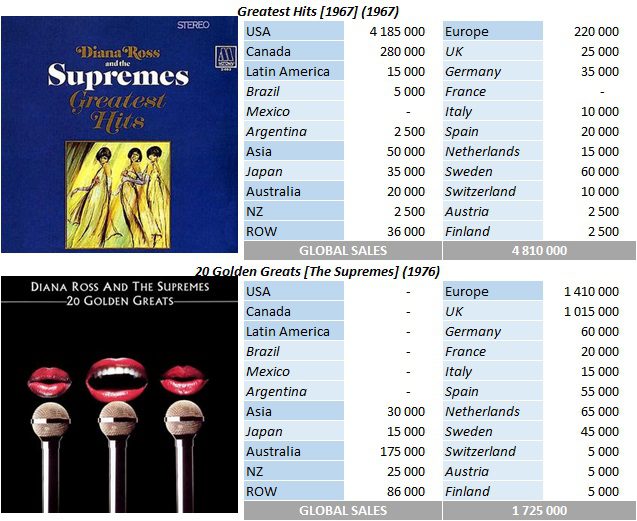
Total Album (all types) Sales per Country

Please note country-specific numbers may miss sales of a few minor releases, although totals are complete. This table does not include albums mostly credited to Diana Ross.
The Supremes Career CSPC Results

So, after checking all the figures, how many overall equivalent album sales has each The Supremes album achieved? Well, at this point we hardly need to add up all of the figures defined in this article!
Albums CSPC results
In the following results table, all categories display figures in equivalent album sales. If different, pure sales are listed between parentheses.
As a reminder:
- Studio Album: sales of the original album
- Other Releases: sales of compilations generated thanks to the album
- Physical Singles: sales of physical singles from the album (ratio 3/10)
- Download Singles: sales of digital singles from the album (ratio 1,5/10)
- Streaming: equivalent album sales of all the album tracks (ratio 1/1500 for Audio stream and 1/6750 for Video stream)
Artist career totals
See where the artist ranks among remaining singers
In a very close race, Where Did Our Love Go leads the way with an impressive 18.7 million sales. The Supremes A’ Go-Go is another monster at 16.5 million. Both are the top 2 most successful female albums of the 60s.
More Hits by the Supremes at 7.3 million and Join the Temptations at 6.7 million are strong too. Lower down, The Supremes Sing Holland–Dozier–Holland does well too at 3.8 million.
Outside of this top 5, albums are hits or misses. The hits, like I Hear a Symphony or Love Child, are around 2 million copies each. In the other side, records with no successful single can be regarded as dead meat nowadays, with totals frozen usually below half a million sales.
Again, we need to point out that these albums came out at an insane pace. To get so many million sellers over such a short span is amazing.
The career total of The Supremes stands at 76 million equivalent album sales. Often forgotten in the much touted best selling female group of all-time debate, they are clearly ahead, with the Destiny’s Child (51 million), the Spice Girls (50 million), and TLC (42 million) quite a lot behind.
Singles CSPC results
The list is compiled in album equivalent sales generated by each song. Therefore, these figures are not merged units of singles formats. Instead, it includes weighted sales of the song’s physical single, download, ringtone and streaming as well as its share among sales of all albums on which it is featured.
Discography results
Thanks to our new ASR (Artist Success Rating) concept, we know that sales represent 32.31 million times the purchase of entire discography. Coupled with total sales, it translates into an ASR score of 268. The ranking of all artists studied so far is available too at this link.Records & Achievements
- At 76,392,000 EAS, The Supremes are the most successful female group of all-time.
- At 18,710,000 EAS, Where Did Our Love Go is the most successful female album from 1960s.
- At 16,522,000 EAS, The Supremes A’ Go-Go is the 2nd most successful female album from 1960s.
- With 12 US #1 hits, The Supremes held the record for a female act until Mariah Carey.
NB: EAS means Equivalent Album Sales.
Dynamic Spotify Key Performance Indicators
The Supremes

Current followers count: 1,726,962 >> Daily breakdown
The Supremes is #2034 among the most followed artists of all-time >> Visit our Top 5,000 most followed artists ranking
Current streams count: 1,339,361,012 1,000,000,000 streams have been reached on 11/23/22 >> Daily breakdown
The Supremes is #1631 among the most streamed artists of all-time Popularity Rating: /100 >> Visit our Top 1,000 most streamed artists ranking >> Visit our Top 20 highest rated artists ranking
Current monthly listeners: 4,648,932 (Trend: -123,653) Global chart position: N/A The artist top 50 cities come from 16 distinct countries >> Global impact breakdown
As usual, feel free to comment and / or ask a question!
Sources: IFPI, Spotify, YouTube, Discogs, Billboard.
You may be interested in…
… The Supremes‘ streaming masters analysis
… checking out the upcoming artists or even voting for them!
… best-selling artists, albums, and singles
We have created amazing cross-artists tops. Click to see all CSPC and raw sales results compiled so far!
… similar artists
To put The Supremes‘ figures into perspective, click to reach career breakdowns of more R&B icons:






























